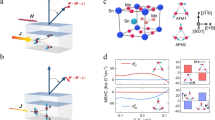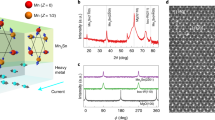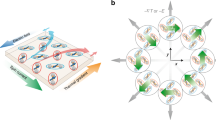Abstract
The discovery of the spin Hall effect1 enabled the efficient generation and manipulation of the spin current. More recently, the magnetic spin Hall effect2,3 was observed in non-collinear antiferromagnets, where the spin conservation is broken due to the non-collinear spin configuration. This provides a unique opportunity to control the spin current and relevant device performance with controllable magnetization. Here, we report a magnetic spin Hall effect in a collinear antiferromagnet, Mn2Au. The spin currents are generated at two spin sublattices with broken spatial symmetry, and the antiparallel antiferromagnetic moments play an important role. Therefore, we term this effect the ‘antiferromagnetic spin Hall effect’. The out-of-plane spins from the antiferromagnetic spin Hall effect are favourable for the efficient switching of perpendicular magnetized devices, which is required for high-density applications. The antiferromagnetic spin Hall effect adds another twist to the atomic-level control of spin currents via the antiferromagnetic spin structure.
This is a preview of subscription content, access via your institution
Access options
Access Nature and 54 other Nature Portfolio journals
Get Nature+, our best-value online-access subscription
$29.99 / 30 days
cancel any time
Subscribe to this journal
Receive 12 print issues and online access
$259.00 per year
only $21.58 per issue
Buy this article
- Purchase on Springer Link
- Instant access to full article PDF
Prices may be subject to local taxes which are calculated during checkout



Similar content being viewed by others
Data availability
Source data are provided with this paper. Any other data that support the findings of this study are available from the corresponding authors on reasonable request.
References
Kato, Y. K., Myers, R. C., Gossard, A. C. & Awschalom, D. D. Observation of the spin Hall effect in semiconductors. Science 306, 1910–1913 (2004).
Kimata, M. et al. Magnetic and magnetic inverse spin Hall effects in a non-collinear antiferromagnet. Nature 565, 627–630 (2019).
Nan, T. X. et al. Controlling spin current polarization through non-collinear antiferromagnetism. Nat. Commun. 11, 4671 (2020).
Baek, S. C. et al. Spin currents and spin-orbit torques in ferromagnetic trilayers. Nat. Mater. 17, 509–513 (2018).
Miron, I. M. et al. Perpendicular switching of a single ferromagnetic layer induced by in-plane current injection. Nature 476, 189–193 (2011).
Liu, L. et al. Spin-torque switching with the giant spin Hall effect of tantalum. Science 336, 555–558 (2012).
Kurebayashi, H. et al. An antidamping spin-orbit torque originating from the Berry curvature. Nat. Nanotechnol. 9, 211–217 (2014).
Jungwirth, T., Marti, X., Wadley, P. & Wunderlich, J. Antiferromagnetic spintronics. Nat. Nanotechnol. 11, 231–241 (2016).
Chen, X. Z. et al. Electric field control of Néel spin-orbit torque in an antiferromagnet. Nat. Mater. 18, 931–935 (2019).
Manchon, A. et al. Current-induced spin-orbit torques in ferromagnetic and antiferromagnetic systems. Rev. Mod. Phys. 91, 035004 (2019).
MacNeill, D. et al. Control of spin-orbit torques through crystal symmetry in WTe2/ferromagnet bilayers. Nat. Phys. 13, 300–305 (2017).
Song, P. et al. Coexistence of large conventional and planar spin Hall effect with long spin diffusion length in a low-symmetry semimetal at room temperature. Nat. Mater. 19, 292–298 (2020).
Sinova, J. et al. Universal intrinsic spin Hall effect. Phys. Rev. Lett. 92, 126603 (2004).
Zhang, W. et al. Giant facet-dependent spin-orbit torque and spin Hall conductivity in the triangular antiferromagnet IrMn3. Sci. Adv. 2, e1600759 (2016).
Oh, Y. W. et al. Field-free switching of perpendicular magnetization through spin-orbit torque in antiferromagnet/ferromagnet/oxide structures. Nat. Nanotechnol. 11, 878 (2016).
Liu, Y. et al. Current-induced out-of-plane spin accumulation on the (001) surface of the IrMn3 antiferromagnet. Phys. Rev. Appl 12, 064046 (2019).
Fukami, S. et al. Magnetization switching by spin-orbit torque in an antiferromagnet–ferromagnet bilayer system. Nat. Mater. 15, 535–541 (2016).
Zhang, W. et al. Spin Hall effects in metallic antiferromagnets. Phys. Rev. Lett. 113, 196602 (2014).
Z˘elezný, J., Zhang, Y., Felser, C. & Yan, B. Spin-polarized current in noncollinear antiferromagnets. Phys. Rev. Lett. 119, 187204 (2017).
González-Hernández, R. et al. Magnetic spin Hall effect in collinear antiferromagnet. Preprint at https://arxiv.org/abs/2002.07073 (2020).
Bodnar, Y. S. et al. Writing and reading antiferromagnetic Mn2Au by Néel spin-orbit torques and large anisotropic magnetoresistance. Nat. Commun. 9, 348 (2018).
Wadley, P. et al. Electrical switching of an antiferromagnet. Science 351, 587–590 (2016).
Zhang, Y., Liu, Q., Miao, B. F., Ding, H. F. & Wang, X. R. Anatomy of electrical signals and dc-voltage line shape in spin-torque ferromagnetic resonance. Phys. Rev. B 99, 064424 (2019).
Liu, L., Moriyama, T., Ralph, D. & Buhrman, R. Spin-torque ferromagnetic resonance induced by the spin Hall effect. Phys. Rev. Lett. 106, 036601 (2011).
Bodnar, Y. S. et al. Imaging of current induced Néel vector switching in antiferromagnetic Mn2Au. Phys. Rev. B 99, 140409 (2019).
Fukami, S. et al. A spin-orbit torque switching scheme with collinear magnetic easy axis and current configuration. Nat. Nanotechnol. 11, 621–625 (2016).
Shi, S. et al. All-electric magnetization switching and Dzyaloshinskii–Moriya interaction in WTe2/ferromagnet heterostructures. Nat. Nanotechnol. 14, 945–949 (2019).
Saglam, H. et al. Independence of spin-orbit torques from the exchange bias direction in Ni81Fe19/IrMn bilayers. Phys. Rev. B 98, 094407 (2018).
Holanda, J. et al. Magnetic damping modulation in IrMn3/Ni80Fe20 via the magnetic spin Hall effect. Phys. Rev. Lett. 124, 087204 (2020).
Zhou, X. F. et al. From fieldlike torque to antidamping torque in antiferromagnetic Mn2Au. Phys. Rev. Appl 11, 054030 (2019).
Wang, Y. et al. Room temperature magnetization switching in topological insulator–ferromagnet heterostructures by spin-orbit torques. Nat. Commun. 8, 1364 (2017).
Acknowledgements
We are grateful for fruitful discussions with J. Yin, D. Weiss, J. Han, K. Cai, P. He, S. D. Pollard and R. Mishra. This work is supported by the National Key R&D Program of China (grant no. 2017YFB0405704), National Natural Science Foundation of China (grant no. 51871130), Natural Science Foundation of Beijing Municipality (grant no. JQ20010) and National Key R&D Program of China (grants no. 2016YFA0203800 and 2017YFB0405604). X.R.W. is supported by Hong Kong RGC (grants no. 16301518 and 16301619).
Author information
Authors and Affiliations
Contributions
C.S. and X.C. designed the experiment. X.C., X.Z. and H.B. grew the thin films. X.C. and G.S. fabricated the devices. X.C., S.S., G.S., H.B. and H.Z. carried out the ST-FMR and MOKE measurements. X.C., X.Z. S.J., Y.Z. and Z.Z. performed the high magnetic field measurements. A.L., Y.C. and X.H. performed the structural characterizations. X.C., L.L., C.S., X.W., X.F. and D.X. proposed the theoretical model. H.W., H.Y. and F.P. gave suggestions on the experiments. C.S., H.Y. and F.P. supervised this study. All authors discussed the results and prepared the manuscript.
Corresponding authors
Ethics declarations
Competing interests
The authors declare no competing interests.
Additional information
Peer review information Nature Materials thanks Byong-Guk Park and the other, anonymous, reviewer(s) for their contribution to the peer review of this work.
Publisher’s note Springer Nature remains neutral with regard to jurisdictional claims in published maps and institutional affiliations.
Supplementary information
Supplementary Information
Supplementary Figs. 1–12, Table 1, Notes 1–13 and references.
Source data
Source Data for Fig. 2.
Source Data
Source Data for Fig. 3.
Source Data
Rights and permissions
About this article
Cite this article
Chen, X., Shi, S., Shi, G. et al. Observation of the antiferromagnetic spin Hall effect. Nat. Mater. 20, 800–804 (2021). https://doi.org/10.1038/s41563-021-00946-z
Received:
Accepted:
Published:
Issue Date:
DOI: https://doi.org/10.1038/s41563-021-00946-z
This article is cited by
-
Highly efficient field-free switching of perpendicular yttrium iron garnet with collinear spin current
Nature Communications (2024)
-
Interfacial magnetic spin Hall effect in van der Waals Fe3GeTe2/MoTe2 heterostructure
Nature Communications (2024)
-
Field-free switching of perpendicular magnetization by two-dimensional PtTe2/WTe2 van der Waals heterostructures with high spin Hall conductivity
Nature Materials (2024)
-
Rotational magnetoelectric switching in orthorhombic multiferroics
npj Computational Materials (2024)
-
Acoustic spin rotation in heavy-metal-ferromagnet bilayers
Nature Communications (2024)



